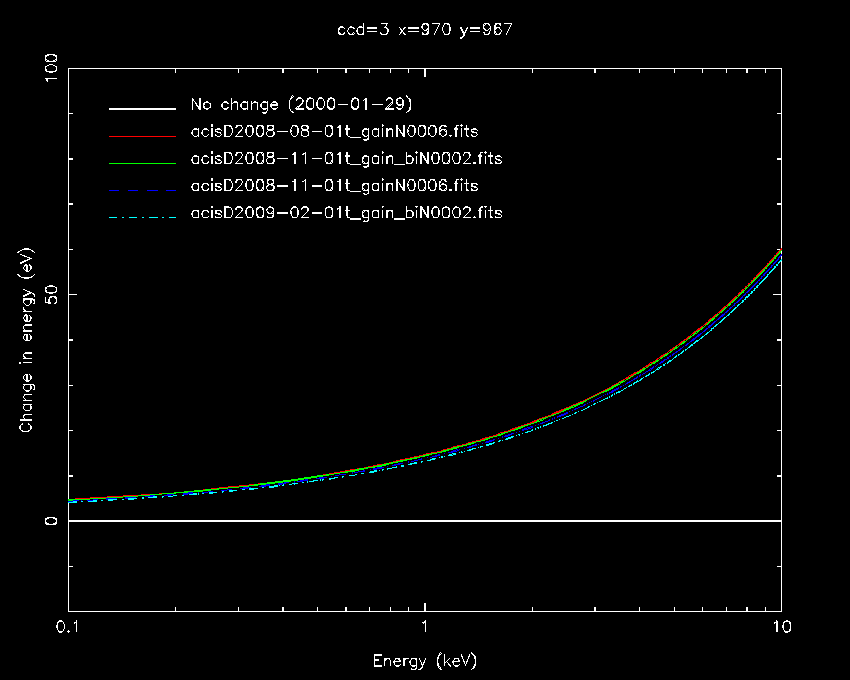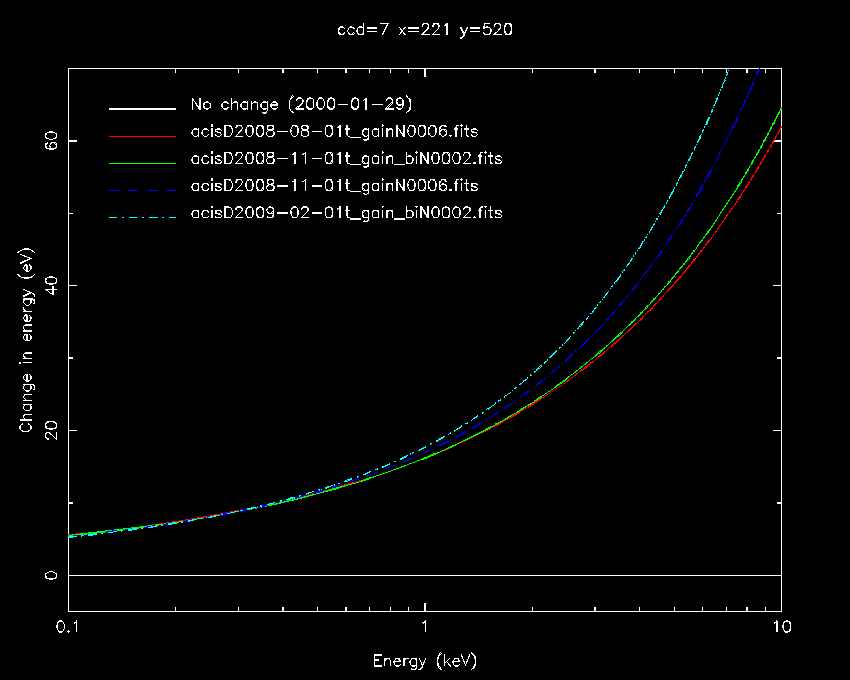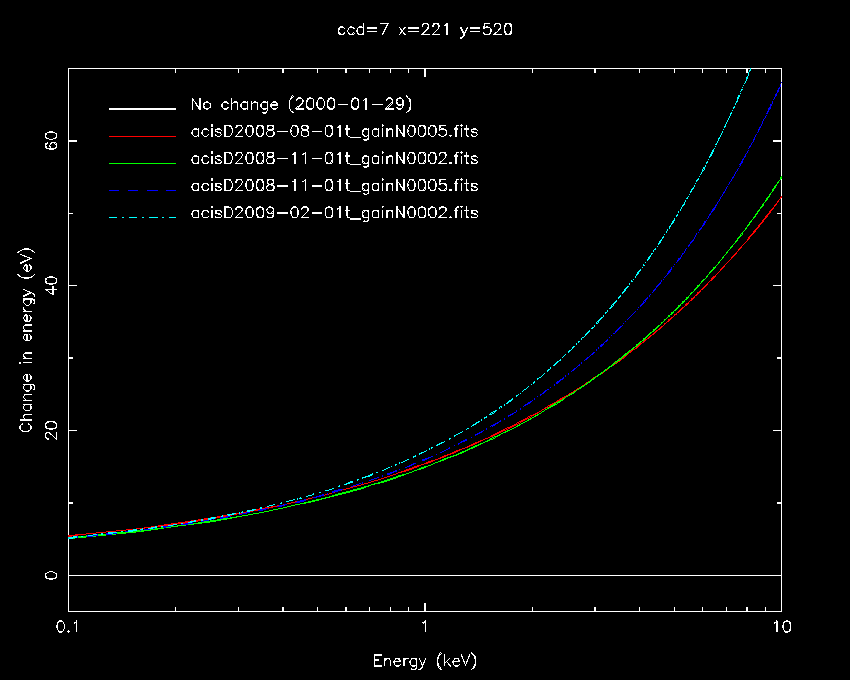CalDB PUBLIC Release Notes
Effective Date:
(UTC) 2009-07-07T16:00:00
SDP Installation Date: 2009-07-13T14:15:00
Public Release Date: 07 July
2009
Version: 4.1.3
Release Type: PUBLIC
I. Introduction
CaldB 4.1.3 is an upgrade to all previous CalDB4 versions
4.1.x. It includes the following upgrades:
- ACIS T_GAIN Epoch 37 (01 Feb through 30 Apr 2009)
- Removal of CTI_APP boundary condition from all ACIS CTI
files; N0006 versions will now be the defaults.
- Corrections to the headers of three ACIS blank-sky
background (BKGRND) files, those applicable to ACIS-6 and ACIS-7 at
-100C focal plane temperature.
Only the new ACIS T_GAIN affects current observations and
processing in any immediate way. See the technical details (Section III
below) for information about how the other changes may affect certain
analyses.
User Documentation:
"How CalDB 4.1.3 Affects Your Analysis"
http://cxc.harvard.edu/ciao/releasenotes/ciao_4.1.2_release.html#HowCALDB4.1.3AffectsYourAnalysis
II. Summary of Changes
A. ACIS T_GAIN Epoch 37
LOCATION: $CALDB/data/chandra/acis/t_gain/
FILENAMES: acisD2008-11-01t_gainN0005.fits
acisD2008-11-01t_gainN0006.fits
acisD2009-02-01t_gain_biN0002.fits
acisD2009-02-01t_gainN0002.fits
The Epoch 37 (Feb-Apr 2009) have now been released as indicated above;
hence the Epoch 36 interpolations (the 2008-11-01 filenames above,
applicable for observation dates Nov 2008 through Jan 2009) are now
finalized. The previous epoch N0002
files have been demoted to "BAD" status, though they are still in the
circulation with the CalDB, just in case they are needed for comparison
to earlier analyses. See the Tech Details below for information on the
degree of effect versus energy that the new corrections will have on
your particular ACIS datasets. These new files will only affect data
with DATE-OBS after 2008-11-01T00:00:00. All earlier data are
unaffected by this change.
Users analyzing observations with DATE_OBS later than 2008-11-01 are
encouraged to reprocess their Level 1 events data through Level 2, to
verify whether or not their previous analysis results are at all
affected by these new data. The plots in Tech Details section III.A
give some a priory
indications of how these data will affect them.
Pipes/Tools affected:
SDP/CIAO tool acis_process_events
Threads affected:
Any thread that employs acis_process_events with the parameter apply_tgain set to "yes", which is
the default state. Specifically,
"Reprocessing to create a new (ACIS) L2 events file"
http://cxc.harvard.edu/ciao/threads/createL2/index.html#acis
B. Removal of the CTI_APP boundary condition from the ACIS CTI files
LOCATION: $CALDB/data/chandra/acis/cti/
FILENAMES: acisD2000-01-29ctiN0005.fits
acisD2002-08-01ctiN0005.fits
acisD2000-01-29ctiN0006.fits
acisD2002-08-01ctiN0006.fits
It has been brought to my attention that an unfortunate behavior
of acis_process_events has been occurring with the use of CIAO 4.1 and
the new CalDB4 setup. Specifically the presence of the CTI_APP boundary
condition with each of the above CTI files causes a-p-e to slip into a
NO-CTI AVAILABLE state when a user removes the CTI corrections, and it
becomes non-trivial to reapply the CTI corrections should they wish to
do so. We remove this quirk by removing the CTI_APP boundary condition
from the file headers of the four files above, provided the CAL_QUAL
values are adjusted to allow the N0006 files to be preferred. We are
releasing this change with CalDB 4.1.3.
Pipes/Tools affected:
CIAO tool acis_process_events
Threads affected:
"Reprocessing to create a new (ACIS) L2 events file"
http://cxc.harvard.edu/ciao/threads/createL2/index.html#acis
C. Correction of the CTI_APP boundary condition in three ACIS -100C
BKGRND files
LOCATION: $CALDB/data/chandra/acis/bkgrnd/
FILENAMES: acis6sD1999-08-12bkgrndN0002.fits
acis7iD1999-08-12bkgrndN0003.fits
acis7sD1999-08-12bkgrndN0002.fits
A helpdesk question was submitted in May 2009 regarding selection of
one of the three -100C ACIS blank-sky background files, and at that
point I discovered an error in three of the BKGRND file headers, listed
above. The CTI_APP boundary condition was misset for these three files
dating from earlier in the program. They went unnoticed in CalDB 3.5.x
because the INDEX file listings had been corrected separately, and the
file headers were thereafter ignored. With the build of the new CalDB 4
setup, the errors became effectual again. In this release, the CTI_APP
boundary condition values have been corrected. Specifically,
CTI_APP='NNNNNNNNNN' for all three of these files.
III. Technical Details
A. ACIS T_GAIN Epoch 37
The total corrections versus photon energy for epoch 37 files, in
eV, are given in the figures below, for the ACIS-I and ACIS-S aimpoint
positions specifically. We note here that corrections a various points
across the chip surface may be rather different, even very
significantly so, from these results.

Fig. 1: Comparison of the total change in eV due to the Epoch
35, 36, and 37 T_GAIN files, for the I3 aimpoint. The red curve is for
Epoch 35,
and interpolates between the epoch 35 and 36 corrections at the
mid-point (average). The 2008-11-01 files are for Epoch 36. The
t_gainN0006.fits file
replaces the t_gain_biN0002.fits file, and there is very little change
at this location on the chip by this upgrade. Other locations will vary
more
significantly. The acisD2009-02-01t_gain_biN0002.fits file is a flat,
non-interpolating file, and will be upgraded after Epoch 38 has been
completed (May 1-Aug 31, 2009).

Fig. 2: A similar plot for the aimpoint of the BI chips S3, with the
CTI corrections applied to the data. For this location and chip the
2008-08-01 file
upgrade is more significant (difference between the solid green and
dashed blue curves), but mainly at the highest energy points above 6
keV. For
the new flat file (cyan dashed curve) more correction seems to be
required above 5 keV than in the previous epochs, but not out of the
ordinary. This
result may be modified by the next epoch data as well.

Fig. 3: The S3 aimpoint corrections for the case where the BI chips are
NOT CTI-corrected at all. (The N0005 files.) As is usually the case,
the corrections are more scattered over the full range for the non-CTI
case. However while these variations are significant relative to the
0.3% gain setting standard for the calibrations, they are not unusually
strong. The cyan dashed curve indicates the strongest variation in
correction values over the range, but again it may be modified in the
next epochal release.



